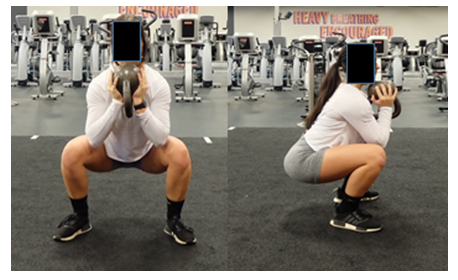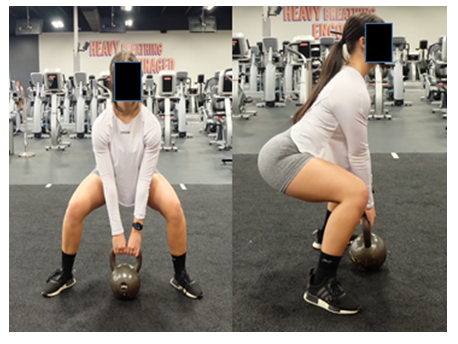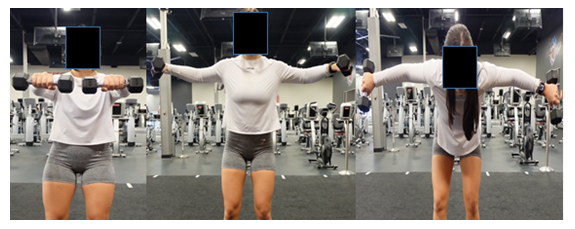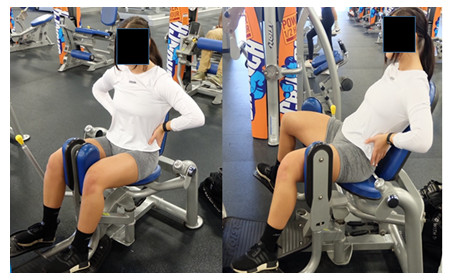Training the Industrial Athlete: Targeted Exercises to Reduce Occupational Injury Risks
Michael Callihan1 *, Megan Leonard2
1Assistant Professor, Capstone College of Nursing at the University of Alabama, 650 University E., Tuscaloosa, AL 35401, USA
2Student Nurse, 9Round Certified Trainer, Capstone College of Nursing at the University of Alabama, 650 University E., Tuscaloosa, AL 35401, USA
*Corresponding Author: Dr. Michael Callihan, PhD, RN, NRP, CEN, ACE, Assistant Professor, Capstone College of Nursing at the University of Alabama, 650 University E., Tuscaloosa, AL 35401, USA
Received: 02 November 2021; Accepted: 11 November 2021; Published: 08 December 2021
Article Information
Citation:
Michael Callihan, Megan Leonard. Training the Industrial Athlete: Targeted Exercises to Reduce Occupational Injury Risks. Journal of Orthopaedics and Sports Medicine 3 (2021): 152-161.
View / Download Pdf Share at FacebookAbstract
Background: Competitive athletes go through rigorous physical training to enhance their performance and to limit their risk for injury. While this is common practice in athletics, the industrial worker often does not undergo similar physical training to maintain efficiency in the work environment while limiting injury risks. This lack in physical preparation often leads to musculoskeletal injury among workers. The purpose of this review is to identify common injury patterns among workers and describe appropriate training methods to maximize the ability of the worker while limiting injury risks.
Methods: Data were reviewed from the Bureau of Labour Statistics to identify the most common body parts suffering musculoskeletal injury. After identifying the most common body parts injured, targeted literature searches were conducted to identify simple physical training activities to address these areas of interest.
Results: The most common areas for musculoskeletal injury are the back, shoulder, hand, and knees.
Discussion: In discussing musculoskeletal injury in the workplace, overexertion is often the cause. Through proper physical conditioning, the worker is able to use their muscle endurance, coordination, balance, and flexibility to limit their risk for injury.
Keywords
Physical fitness; Microtrauma; Occupational health; Occupational injuries
Competitive athletes articles Competitive athletes Research articles Competitive athletes review articles Competitive athletes PubMed articles Competitive athletes PubMed Central articles Competitive athletes 2023 articles Competitive athletes 2024 articles Competitive athletes Scopus articles Competitive athletes impact factor journals Competitive athletes Scopus journals Competitive athletes PubMed journals Competitive athletes medical journals Competitive athletes free journals Competitive athletes best journals Competitive athletes top journals Competitive athletes free medical journals Competitive athletes famous journals Competitive athletes Google Scholar indexed journals Sport articles Sport Research articles Sport review articles Sport PubMed articles Sport PubMed Central articles Sport 2023 articles Sport 2024 articles Sport Scopus articles Sport impact factor journals Sport Scopus journals Sport PubMed journals Sport medical journals Sport free journals Sport best journals Sport top journals Sport free medical journals Sport famous journals Sport Google Scholar indexed journals Physical training articles Physical training Research articles Physical training review articles Physical training PubMed articles Physical training PubMed Central articles Physical training 2023 articles Physical training 2024 articles Physical training Scopus articles Physical training impact factor journals Physical training Scopus journals Physical training PubMed journals Physical training medical journals Physical training free journals Physical training best journals Physical training top journals Physical training free medical journals Physical training famous journals Physical training Google Scholar indexed journals Tennis player articles Tennis player Research articles Tennis player review articles Tennis player PubMed articles Tennis player PubMed Central articles Tennis player 2023 articles Tennis player 2024 articles Tennis player Scopus articles Tennis player impact factor journals Tennis player Scopus journals Tennis player PubMed journals Tennis player medical journals Tennis player free journals Tennis player best journals Tennis player top journals Tennis player free medical journals Tennis player famous journals Tennis player Google Scholar indexed journals Musculoskeletal injuries articles Musculoskeletal injuries Research articles Musculoskeletal injuries review articles Musculoskeletal injuries PubMed articles Musculoskeletal injuries PubMed Central articles Musculoskeletal injuries 2023 articles Musculoskeletal injuries 2024 articles Musculoskeletal injuries Scopus articles Musculoskeletal injuries impact factor journals Musculoskeletal injuries Scopus journals Musculoskeletal injuries PubMed journals Musculoskeletal injuries medical journals Musculoskeletal injuries free journals Musculoskeletal injuries best journals Musculoskeletal injuries top journals Musculoskeletal injuries free medical journals Musculoskeletal injuries famous journals Musculoskeletal injuries Google Scholar indexed journals Joint articles Joint Research articles Joint review articles Joint PubMed articles Joint PubMed Central articles Joint 2023 articles Joint 2024 articles Joint Scopus articles Joint impact factor journals Joint Scopus journals Joint PubMed journals Joint medical journals Joint free journals Joint best journals Joint top journals Joint free medical journals Joint famous journals Joint Google Scholar indexed journals Healthcare worker articles Healthcare worker Research articles Healthcare worker review articles Healthcare worker PubMed articles Healthcare worker PubMed Central articles Healthcare worker 2023 articles Healthcare worker 2024 articles Healthcare worker Scopus articles Healthcare worker impact factor journals Healthcare worker Scopus journals Healthcare worker PubMed journals Healthcare worker medical journals Healthcare worker free journals Healthcare worker best journals Healthcare worker top journals Healthcare worker free medical journals Healthcare worker famous journals Healthcare worker Google Scholar indexed journals Muscle fatigue articles Muscle fatigue Research articles Muscle fatigue review articles Muscle fatigue PubMed articles Muscle fatigue PubMed Central articles Muscle fatigue 2023 articles Muscle fatigue 2024 articles Muscle fatigue Scopus articles Muscle fatigue impact factor journals Muscle fatigue Scopus journals Muscle fatigue PubMed journals Muscle fatigue medical journals Muscle fatigue free journals Muscle fatigue best journals Muscle fatigue top journals Muscle fatigue free medical journals Muscle fatigue famous journals Muscle fatigue Google Scholar indexed journals Cardiorespiratory endurance articles Cardiorespiratory endurance Research articles Cardiorespiratory endurance review articles Cardiorespiratory endurance PubMed articles Cardiorespiratory endurance PubMed Central articles Cardiorespiratory endurance 2023 articles Cardiorespiratory endurance 2024 articles Cardiorespiratory endurance Scopus articles Cardiorespiratory endurance impact factor journals Cardiorespiratory endurance Scopus journals Cardiorespiratory endurance PubMed journals Cardiorespiratory endurance medical journals Cardiorespiratory endurance free journals Cardiorespiratory endurance best journals Cardiorespiratory endurance top journals Cardiorespiratory endurance free medical journals Cardiorespiratory endurance famous journals Cardiorespiratory endurance Google Scholar indexed journals Shoulder articles Shoulder Research articles Shoulder review articles Shoulder PubMed articles Shoulder PubMed Central articles Shoulder 2023 articles Shoulder 2024 articles Shoulder Scopus articles Shoulder impact factor journals Shoulder Scopus journals Shoulder PubMed journals Shoulder medical journals Shoulder free journals Shoulder best journals Shoulder top journals Shoulder free medical journals Shoulder famous journals Shoulder Google Scholar indexed journals Hand articles Hand Research articles Hand review articles Hand PubMed articles Hand PubMed Central articles Hand 2023 articles Hand 2024 articles Hand Scopus articles Hand impact factor journals Hand Scopus journals Hand PubMed journals Hand medical journals Hand free journals Hand best journals Hand top journals Hand free medical journals Hand famous journals Hand Google Scholar indexed journals Lower extremities articles Lower extremities Research articles Lower extremities review articles Lower extremities PubMed articles Lower extremities PubMed Central articles Lower extremities 2023 articles Lower extremities 2024 articles Lower extremities Scopus articles Lower extremities impact factor journals Lower extremities Scopus journals Lower extremities PubMed journals Lower extremities medical journals Lower extremities free journals Lower extremities best journals Lower extremities top journals Lower extremities free medical journals Lower extremities famous journals Lower extremities Google Scholar indexed journals Muscular strength articles Muscular strength Research articles Muscular strength review articles Muscular strength PubMed articles Muscular strength PubMed Central articles Muscular strength 2023 articles Muscular strength 2024 articles Muscular strength Scopus articles Muscular strength impact factor journals Muscular strength Scopus journals Muscular strength PubMed journals Muscular strength medical journals Muscular strength free journals Muscular strength best journals Muscular strength top journals Muscular strength free medical journals Muscular strength famous journals Muscular strength Google Scholar indexed journals Weight lifting articles Weight lifting Research articles Weight lifting review articles Weight lifting PubMed articles Weight lifting PubMed Central articles Weight lifting 2023 articles Weight lifting 2024 articles Weight lifting Scopus articles Weight lifting impact factor journals Weight lifting Scopus journals Weight lifting PubMed journals Weight lifting medical journals Weight lifting free journals Weight lifting best journals Weight lifting top journals Weight lifting free medical journals Weight lifting famous journals Weight lifting Google Scholar indexed journals Physical fitness articles Physical fitness Research articles Physical fitness review articles Physical fitness PubMed articles Physical fitness PubMed Central articles Physical fitness 2023 articles Physical fitness 2024 articles Physical fitness Scopus articles Physical fitness impact factor journals Physical fitness Scopus journals Physical fitness PubMed journals Physical fitness medical journals Physical fitness free journals Physical fitness best journals Physical fitness top journals Physical fitness free medical journals Physical fitness famous journals Physical fitness Google Scholar indexed journals
Article Details
1. Background
Competitive athletes undergo rigorous physical training to enhance their level of performance in their sport as well as to limit the injury risks to those athletes. These physical training regiments include a variety of overall strengthening exercises, improved cardiovascular performance, flexibility, as well as specific exercises to match the tasks they are being asked to perform. In practice, the strength and conditioning program for an offensive lineman looks much different than that of a tennis player.
Musculoskeletal injuries raise a major concern in the industrial setting, with roughly 87 workers out of every 10,000 sustaining a musculoskeletal injury every year requiring them to miss days of work [1]. The constant walking, bending, lifting, and moving required in the workplace often forces the worker to be in an awkward position, adding stress on the joints of the body [2-5].
This awkward position increases the way the muscles fatigue leading the worker to modify their movement patterns to compensate for the weakness. However, this modification increases the chance for injury to these at-risk areas [3].
2. Risk Factors
Most injury prevention techniques hinge on decreasing the fatigue and the workload of the employee to guide injury mitigation techniques [1]. Injury prevention models depend on the NIOSH hierarchy of controls of removing the hazard, substitution to replace the hazard, engineering controls to isolate people from the hazard, administrative controls that change the way people work, and personal protective equipment (PPE) to protect the worker from exposure [6]. While these mitigation efforts are beneficial in preventing some hazards, the ability of the worker is not considered. Engineering controls, such as using a lifting device, still often require the worker to manipulate a load or assume an abnormal position when working. This abnormal positioning during lifting and moving causes a variation in lifting techniques, adding stress to structures of the musculoskeletal system and increasing the risk of injury.
Variation in lifting technique leads to muscle fatigue at varying rates forcing a worker to compensate for the weakness by altering their body position while performing lifting tasks [7]. Proper body positioning is critical for the optimal activation of muscles during the lifting process and will affect the amount of muscle fatigue associated with the movement [8-9]. The level of fatigue in a muscle alters the activation of the muscles needed to perform a task, thus changing where the stress is placed on the supporting joints, increasing the risk of injury to the worker [9]. While proper positioning is imperative to maintain musculoskeletal well-being of the healthcare worker, current workloads increase fatigue and make this difficult.
Athletes are trained with muscles and joints conditioned to match the type of activity they will be performing in an effort to improve their performance while limiting the risk of injury. While this practice is common in the athletic arena it is often overlooked in the occupational setting. Proper strength and flexibility, coupled with endurance training will lead to a better physically prepared worker that can focus on work rather than the distractions of muscle fatigue, injury, and pain.
Research has shown that an employee that exercises more than four hours per week has seen a reduction in injury rates by as much as 25% when compared to an employee that exercises less than 2 hours [10]. A combination of anaerobic training to strengthen the body to work with a load [11] and aerobic training to develop muscle endurance [12] will better to prepare the worker to maintain their musculoskeletal health while handling the workload and maintaining proper body positioning [13, 14].
Proper body positioning and added spinal stability associated with strength training will help in training the worker to maintain proper biomechanics in the lifting process and help to reduce musculoskeletal injuries [15-17]. The purpose of this paper is to identify the most common body regions that are injured among workers and describe appropriate strength training techniques that can improve the body positioning, fatigue levels, and the strength necessary to safely perform occupational tasks.
3. Methods
Data were explored for musculoskeletal problems utilizing the Bureau of Labor Statistics Database (2020). Following the identification of the most commonly injured body regions, targeted literature searches were conducted to examine causative factors for each injury and simple exercises to help prevent the injuries.
4. Results
According to Bureau of labor statistics data for 2019 [1], 888,220 workers experience musculoskeletal injuries that resulted in having to miss at least one day of work. The most injured body part for the worker was the back (136,190). The upper extremities was the most injured body group (284,860) with the shoulder (67,020) and hand (121,000) being the most commonly injured areas. The lower extremities (216,850) were the second most injured portion of the body with the knee (78,240) being the most commonly injured region. It is important to note, 82,650 reported injuries consisted of multiple body parts injured [1].
4.1 Causes
Strains and sprains with the most common type of injury reported among workers with 28.9 injuries occurring for every 10,000 [1]. These injuries are often (31%) caused by overexertion followed by falls (27%) and contact with an object (26%). Contact with an object is often a contributing factor to hand injuries, with human error being the primary cause of this type of injury [18].
5. Therapeutics
The American College of Sports Medicine (ACSM) divides physical fitness into two components, health-related fitness and skill-related fitness [19]. ACSM includes cardiorespiratory endurance, body composition, muscular strength, muscular endurance, and flexibility as the components of health-related fitness. Agility, coordination, balance, power, reaction time, and speed make up the components of skill-related fitness [19]. While agility, reaction time, and speed are important skill-related factors for a worker, these are developed with hands on training in care tasks. The targeted training for a worker revolves around building coordination, balance, and power to perform a task. This is accomplished through training in muscular strength, cardiorespiratory and muscular endurance, and flexibility.
6. Training the Industrial Athlete
When training the worker as an industrial athlete, one must take into consideration the tasks being performed as well as the most common injuries seen. Workers are frequently tasked with lifting and moving materials and equipment of various sizes from various positions. This variation makes it imperative that the worker maintains core stabilization, activates the posterior chain when lifting, and minimizes the distance from the load to the center of the spine [2]. These basic lifting principles are fundamental to weight lifting [14] and should be used to train the industrial athlete. Core activation is a fundamental portion of any training program in weightlifting and should be a foundation in worker safety training. One such method includes the worker standing up straight with shoulders back, chest out, and feet approximately shoulder width apart. The worker then will squeeze their gluteal muscles as tightly as they can, then take a deep breath and exhale. During the exhale, the participant will squeeze their abdominal muscles. The participant can then relax their gluteal muscles while maintaining tension on the abdominal muscles [14]. This “active core” should be standard practice for all employees while working.
6.1 Back
When discussing injuries to the back, one must consider the stabilizing ability of the core. The core consists of the abdominal muscles as well as those in the back, and form a protective cylinder around the spine. Back injury prevention methods should include both strengthening exercise and flexibility. Together, these increase the ability of the core to stabilize the spine and limit the risk of injury [20]. Proper positioning of the feet and, activation of the core and posterior chain all add to the stability of the spine during the lifting and moving motions. To achieve good flexibility, range of motion, and strengthening of the core muscles, compound movements can be used. Movements such as the squat (Figure 1) and deadlift (Figure 2) require the lifter to set their feet correctly, tighten their core, then travel, under load through the movement. This movement allows the lifter to train their body to maximize activation of the core and posterior chain while in motion. Table 1 describes all of the lifting movements.

Figure 1: Squat with kettlebell.

Figure 2: Deadlift using kettlebell.

Figure 3: Shoulder raises. Front raise, lateral raise, and rear raise.

Figure 4: Inner and outer thigh machine at finish position of each movement.
|
Movement |
Technique |
|
A. A. Core Activation [14] |
a. Stand up straight Shoulders back Tighten Glutes Breathe deep and on exhale tighten abs Let glutes relax |
|
B. Squat [21] |
1. Start with the feet about shoulder width apart and slightly toed out. 2. Keep your head up looking slightly above parallel. 3. Do not look down at all; ground is in peripheral vision only. 4. Accentuate the normal arch of the lumbar curve and then pull the excess arch out with the abs. 5. Keep the midsection very tight. 6. Send your butt back and down. 7. Your knees track over the line of the foot. 8. Do not let the knees roll inside the foot. Keep as much pressure on the heels as possible. 9. Stay off of the balls of the feet. 10. Delay the knees’ forward travel as much as possible. 11. Lift your arms out and up as you descend. (a kettlebell can be held in front of chest for added resistance) 12. Keep your torso elongated. 13. Send hands as far away from your butt as possible. 14. In profile, the ear does not move forward during the squat, it travels straight down. 15. Do not let the squat just sink, but pull yourself down with your hip flexors. 16. Do not let the lumbar curve surrender as you settle in to the bottom. 17. Stop when the fold of the hip is below the knees– break parallel with the thigh. 18. Squeeze glutes and hamstrings and rise without any leaning forward or shifting of balance. 19. Return on the exact same path as you descended. 20. Use every bit of musculature you can; there is no part of the body uninvolved. 21. On rising, without moving the feet, exert pressure to the outside of your feet as though you were trying to separate the ground beneath you. 22. At the top of the stroke, stand as tall as you possibly can. |
|
C. Kettlebell deadlift [22] |
1. Start position- feet between hip and shoulder width apart with toes pointing in direction you are facing 2. With chest open, shoulders back and down, fold at hips, shifting weight to heels. Grab KB with 2 hands 3. Inhale through nose, tighten abs and glutes, drive off your heels extending your hips and knees until in upright position. 4. Fold at hips, reverse motion until weight is on ground |
|
D. Face Pulls |
1. With feet shoulder width apart, reach up and grasp the handles of a rope attached to a pulley or a resistance band attached slightly higher than eye level 2. Step back until arms are fully extended. Engage your core per above, then lean slightly back 3. Roll the shoulders back slightly to engage the muscles. This is the start position 4. Pull the handles or the resistance band toward your forehead keeping palms in and allowing the elbows to flare out. This allows the rear deltoids to be the primary mover for the exercise. 5. Reverse the movement and return to the start position |
Table 1: Description of select exercise movements.
6.2 Shoulder
Subscapular stabilization is a necessity when utilizing the shoulders during a lifting motion. Strengthening of the subscapularis muscle is of vital importance to stabilize the shoulder when lifting. The subscapularis is vital in maintaining the humeral head in the glenoid socket when performing functional movements with the arms. Strengthening of the subscapularis can be accomplished through short range internal rotation of the arm. Another exercise to improve subscapular stabilization is the high face pull motion which targets the rear deltoids, rhomboids, and the external rotators of the shoulder. This movement is described in table 1. Shoulder strength and conditioning must also be considered for injury prevention. Strengthening all three heads of the deltoid is a critical component in injury prevention methods.
This can be accomplished using dumbbells in the front raise, side raise, and rear deltoid raise (Figure 3). Relative equality in the strength of the muscles of the deltoid allows for stability in the shoulder during functional movement patterns.
6.3 Hand
It has been found that human error is the most common cause for workplace injury to the hand [18]. Current preventative measures include engineering and administrative controls as well as the use of PPE to limit the hazards [18]. While these controls have helped in the reduction of injuries, achieving improved muscular endurance and cognitive functioning for the worker [23, 24] through exercise would serve to improve upon the human error portion of the equation.
6.4 Knee
Positioning of the knee when under load is critical in injury prevention methods. The valgus or caved in positioning of the knee adds pressure across the knee, loading the ligaments and tendons in a highly stressful manner. The valgus positioning can be seen in both the squat and stoop lifting positions, as well as during the normal gait cycle of a worker as they walk through the industrial site. While catastrophic failure of the knee is not seen with every movement, the micro-trauma created within the knee relative to the valgus position sets up the worker for injury in the long run. Avoiding the valgus position of the knee is often coached in athletes when doing both the squat and the deadlift. The verbal cue of “knees out” is heard in gyms around the world. The training of the knee to track in line or with a slightly outward positioning during the lifting process serves to reduce the force across the knee, through the hip, and into the lower back. This caved in knee is often the result of a strength mismatch between the inner and outer thigh and limited flexibility of the IT band. To correct the athlete should regularly stretch the IT band, then use the inner and outer thigh machine (Figure 4) (or bands) to correct the strength differential in the legs.
7. Conclusions
When discussing injury in the workplace it is an important finding that overexertion is the leading cause of injury among all work groups. It is interesting to note that while overexertion is the focus of most injury prevention interventions, it still remains the leading cause for workplace injury. Engineering control has been implemented in many situations but are either ignored by workers or inadequate in completely removing the work load on the worker. The traditional methods for injury prevention described earlier, which include removing the hazard, substitution to replace the hazard, engineering controls to isolate people from the hazard, administrative controls that change the way people work, and personal protective equipment (PPE) to protect the worker from exposure [6] do not seem sufficient. The one constant in every injury is the presence of a worker. The training of the worker to be an industrial athlete to function appropriately allows for the efficient use of the engineered controls and added body preparation for the worker in those instances where the hazard cannot be removed, and engineering controls are not possible.
Athletes around the world prepare for their competition through guided exercise and conditioning programs. The training of a worker must be done with the same targeted approach. Injury patterns across industry show that the lower back, shoulder, and knee are all areas of great concern for musculoskeletal injury. With the proper training the risk of injury can be reduced leading to healthier workers both in and out of the work environment. While this is not an all-inclusive list of exercises needed to train the industrial athlete, it brings attention the idea of training a worker in similar methods as training an athlete. Specific training to enhance the performance of the worker in their task, as well as limit the risk of injury is a critical component in our training programs.
The proper use of engineering controls are the most effective way to limit the risk of musculoskeletal injuries and cannot be replaced by any type of educational or fitness program; however, the inclusion of such programs are essential to maximize the benefits of these tools. The worker, a non-controlled factor in every industrial process, must be properly prepared to perform in an efficient and safe manner, trained as an industrial athlete.
References
- Incidence rates of nonfatal occupational injuries and illnesses by case type and ownership, selected industries. Bureau of Labor Statistics (2015).
- Callihan ML, Eyer JC, McCoy CJ, et al. Development and Feasibility Testing of a Contextual Patient Movement Intervention. J Emerg Nurs (2020).
- Gallagher S, Marras WS, Litsky AS, et al. Torso flexion loads and the fatigue failure of human lumbosacral motion segments. Spine (Phila Pa 1976) 30 (2005): 2265-2273.
- Gallagher S, Schall MC, Sesek RF, et al. An Upper Extremity Risk Assessment Tool Based on Material Fatigue Failure Theory: The Distal Upper Extremity Tool (DUET). Hum Factors (2018): 18720818789319.
- Winter DA. Biomechanics and Motor Control of Human Movement (fourth ed.). John Wiley and Sons, Inc. (2009).
- Hierarchy of Controls (2021).
- Escamilla RF, Francisco AC, Fleisig GS, et al. A three-dimensional biomechanical analysis of sumo and conventional style deadlifts. Med Sci Sports Exerc 32 (2000): 1265-1275.
- Gallagher S, Unger RL. Lifting in four restricted lifting conditions: Psychophysical, physiological and biomechanical effects of lifting in stooped and kneeling postures. Applied Ergonomics 21 (1990): 237-245.
- Hooper DR, Szivak TK, Comstock BA, et al. Effects of fatigue from resistance training on barbell back squat biomechanics. J Strength Cond Res 28 (2014): 1127-1134.
- Bern SH, Brauer C, Moller KL, et al. Baggage handler seniority and muskuloskeletal symptoms: is heavy lifting in awkward positions associated with the risk of pain? BMJ Open 8 (2013).
- Winett RAaCRN. Potential health-related benefits of resistance training. Prev Med 33 (2001): 503-513.
- Parkkari J, Natri A, Kannus P, et al. A controlled trial of the health benefits of regular walking on a golf course. Am J Med 109 (2000): 102-108.
- Glassman G. The CrossFit Level 1 Training Guide. The CrossFit Journal (2007).
- Starrett KaCG. Becoming a Supple Leopard: The Ultimate Guide to Resolving Pain, Preventing INjury, and Optimizing Athletic Performance. Victory Belt Publishing Inc. (2013).
- Chimera NJ, Smith CA, Warren M. Injury history, sex, and performance on the functional movement screen and Y balance test. J Athl Train 50 (2015): 475-485.
- Heydari A, Nargol AVF, Jones APC, et al. EMG Analysis of lumbar paraspinal muscles as a predictor of the risk of low-back pain. European Spine Journal 19 (2010): 1145-1152.
- Vieira EaKS. Safety analysis of patient transfers and handling tasks. Quality and Safety in Health Care 18 (2009): 380-384.
- Collier C. Hand Safety and Injury Prevention. HIS (2021).
- American College of Sports Medicine, Liguori G, Feito Y, et al. ACSM's guidelines for exercise testing and prescription (Eleventh edition. ed.). Wolters Kluwer (2021).
- Karas BE, Conrad KM. Back injury prevention interventions in the workplace: an integrative review. AAOHN J 44 (1996): 189-196.
- Glassman G. The CrossFit Level 1 Training Guide. The CrossFit Journal (2016).
- Martone J. Kettlebell Rx: A More Excellent Way. Victory Belt Publishing Inc. (2011).
- Falck RS, Davis JC, Best JR, et al. Impact of exercise training on physical and cognitive function among older adults: a systematic review and meta-analysis. Neurobiol Aging 79 (2019): 119-130.
- Mikkelsen K, Stojanovska L, Polenakovic M, et al. Exercise and mental health. Maturitas 106 (2017): 48-56.


 Impact Factor: * 5.3
Impact Factor: * 5.3 Acceptance Rate: 73.64%
Acceptance Rate: 73.64%  Time to first decision: 10.4 days
Time to first decision: 10.4 days  Time from article received to acceptance: 2-3 weeks
Time from article received to acceptance: 2-3 weeks 